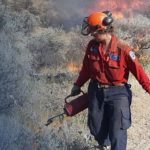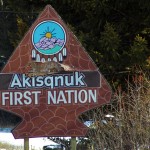Home »

STRIVE program provides many levels of support
As a Board Director with the Kimberley and District Community Foundation (KDCF), I had been invited to attend the STRIVE Program to see how our support was bolstering program resources. In providing participants with bus passes so they can get together, and pool passes, KDCF is helping them stay healthy and reducing their barriers to quality of life. This was my experience:
The first thing I heard was laughter; the first thing I smelled was a savoury chicken soup, and the first thing I felt was the warmth of the kitchen drawing me into the basement of the Marysville Community Church on a Thursday afternoon. The first thing I saw was a group of adults helping one of their compatriots make her way down the short set of steps to join them in the fellowship area of banquet tables and chairs.
I took these all as good signs that I was in the right place. I had been invited to visit the Kootenay Brain Injury Association STRIVE Program, a weekly peer support group for adults living with brain injuries or strokes. This program runs all year round and provides many levels of supports to its participants.
Most of the participants have been attending for years, the newest having joined just over 12 months ago.
On the day I was fortunate enough to visit, there were six participants and the facilitator, Bill Roberts.
This group of adults of varying ages warmly welcomed me as we sat down and visited over coffee while the chicken soup finished its simmer. For about an hour everyone traded stories and laughs, anecdotes about how their week was going for better and for worse.
Participants worked on crafts such as weaving or played cards that helped them with their motor skills and keeping them present and focused. They all took turns listening, joining in with easy laughter and fierce support for their compatriots when they heard about the hard times and stumbling blocks.
I was very honoured and humbled when many of them shared the stories of their injuries or strokes and their healing journeys.
We all helped to set the table and serve the soup and oven-fresh rolls. The participants were also very excited to have fruit salad for dessert as well as the special treat of a homemade banana bread brought by one of them. The STRIVE Program provides balanced and nutritious meals for participants and sends home leftovers to help tide them over and ensure a good meal at home. Clean up from lunch was a snap with many hands making light work and I was impressed at how well everyone did their chores and worked together, compensating for the fact that most of them have only one good hand and arm to work with.
After everyone had had their fill and everything was cleaned up, the program transitioned into the wellness part of the afternoon.
Currently, the STRIVE participants are working through a wellness wheel program that focuses on the different aspects of someone’s life – mental health, physical activity, emotional health, nutrition, etc. Each week they work through a different module and learn strategies, tools, tips and techniques to lead their best life. The STRIVE Program will often have speakers come in to discuss topics like depression, addiction or gambling as individuals with brain injuries are very susceptible to and struggle with these issues.
What I took from my time with the STRIVE Group was that no one wants their life to change or their body to be different.
It can be even more difficult when we experience the devastating toll of an “invisible” injury or disability that has a very real impact on every aspect of life. One that leaves a physical and emotional aftermath in its wake that can’t always been seen by others. But once we acknowledge the reality of our situation, we start down the path of betterment and improvement.
The power of this group is shared experience and relationships. Participants demonstrate what works and proof that it can actually work. They are reminders and points of re-focus, providing emotional support, perspective, and listening to help with burdens. Their warm hearts to help each other through the tough times and provide reminders to keep trying. The path to recovery is very different for each individual, but human connection seems to be an important and transformative part of healing.
The STRIVE Program assists participants in improving their motor and language skills, (re)learning life skills, and provides them with an outing each week with nutritious food, good company and quality support as they navigate their lives and their recovery.
If you or anyone in your life has experienced a brain injury, please reach out to the Kootenay Brain Injury Association for more information on supports, resources and programming at their website.
I’m so pleased the Kimberley and District Community Foundation has the resources to help this worthwhile group.
If you would like to learn more about KDCF, please contact us here or our Facebook page.
Lead image: University of California San Francisco
Josie Cale is president of the Kimberley and District Community Foundation








